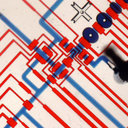Cinobufagin suppresses colorectal cancer angiogenesis by disrupting the endothelial mammalian target of rapamycin/hypoxia-inducible factor 1α axis.
Mots clés
Abstrait
Inducing angiogenesis is a hallmark of cancers that sustains tumor growth and metastasis. Neovascularization is a surprisingly early event during the multistage progression of cancer. Cinobufagin, an important bufadienolide originating from Chan Su, has been clinically used to treat cancer in China since the Tang dynasty. Here, we show that cinobufagin suppresses colorectal cancer (CRC) growth in vivo by downregulating angiogenesis. The hierarchized neovasculature is significantly decreased and the vascular network formation is disrupted in HUVEC by cinobufagin in a dose-dependent way. Endothelial apoptosis is observed by inducing reactive oxygen species (ROS) accumulation and mitochondrial dysfunction which can be neutralized by N-acetyl-l-cysteine (NAC). Expression of hypoxia-inducible factor 1α (HIF-1α) is reduced and phosphorylation of mTOR at Ser2481 and Akt at Ser473 is downregulated in HUVEC. Endothelial apoptosis is triggered by cinobufagin by stimulation of Bax and cascade activation of caspase 9 and caspase 3. Increased endothelial apoptosis rate and alterations in the HIF-1α/mTOR pathway are recapitulated in tumor-bearing mice in vivo. Further, the anti-angiogenesis function of cinobufagin is consolidated based on its pro-apoptotic effects on an EOMA-derived hemangioendothelioma model. In conclusion, cinobufagin suppresses tumor neovascularization by disrupting the endothelial mTOR/HIF-1α pathway to trigger ROS-mediated vascular endothelial cell apoptosis. Cinobufagin is a promising natural anti-angiogenetic drug that has clinical translation potential and practical application value.


